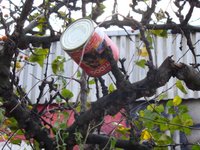FINALly, my FINAL project's FINAL essay!
 The following is the essay that I wrote explaining my final project for the Roadtrip. The photographs are from NYC, London, Amsterdam, and Berlin, respectively.
The following is the essay that I wrote explaining my final project for the Roadtrip. The photographs are from NYC, London, Amsterdam, and Berlin, respectively. I titled my project Urban Anatomy because I felt that this title reflected the shift in focus that my project made from documenting how “garbage can be beautiful” to using it to become more intimately acquainted with the cities in which we traveled. I developed this project because I wanted to see whether garbage could tell me anything new or insightful about the nature of a city and the people in it beyond the sometimes superficial images with which I was presented, both on a citywide level (e.g. banners decrying the great nature of the city) and a personal level (such as fashion sense).
The initial inspiration for my documentation of garbage came in New York City when I noticed piles of garbage bags in and on many of the streets. The bags caught my attention because I am accustomed to seeing them in garbage cans instead of simply on the sidewalk. I wondered whether the bags of garbage bothered the people of New York, but they didn’t seem to; I watched numerous people throw their own garbage into the already heaping piles with unconcerned expressions on their faces. After acknowledging that throwing bags out of doors is simply the way that garbage is handled in New York, I became less disturbed by and more interested in the subject of urban garbage. I then decided to take as many photographs of garbage/discarded items in each of the four cities as I could and narrow them down to 50 in order to explore this subject in depth, not really knowing whether or not this would be my “final project,” but knowing that it was of interest to me.
 While thinking about garbage and its apparently ubiquitous presence in large, urban settings, I decided that in order to better explore the fairly broad question of “What can garbage tell me about a city and the people in it,” I should focus not on documenting garbage in general, but on individual pieces of litter, rubbish, and discarded objects. Thus, I decided to photograph primarily individual objects or take close ups of small sections of rubbish piles. As soon as I implemented this idea into my work, the quality of my photographs improved greatly, both in terms of subject and composition.
While thinking about garbage and its apparently ubiquitous presence in large, urban settings, I decided that in order to better explore the fairly broad question of “What can garbage tell me about a city and the people in it,” I should focus not on documenting garbage in general, but on individual pieces of litter, rubbish, and discarded objects. Thus, I decided to photograph primarily individual objects or take close ups of small sections of rubbish piles. As soon as I implemented this idea into my work, the quality of my photographs improved greatly, both in terms of subject and composition.In order to further expand upon my central concern with this project, I thought of several sub-questions that helped develop the first. These questions and their subsequent answers include:
-What does the term “garbage” constitute?
I came to define “garbage” as pretty much any object that I saw on the street, because, to me, the fact that an item was on the street indicated that its primary purpose had been fulfilled, and that someone had made the conscious decision to discard it.
-Is garbage similar in different cities? Different countries?
Garbage was pretty similar across the four cities we visited. The product names of different pieces of rubbish changed, but the same types of products were discarded, such as alcohol bottles, fast food wrappers, newspapers, paper cups, and the odd article of clothing.
-What are the most discarded items?

Cigarette butts were by far the most discarded item that I found, especially in Berlin; in some areas it seemed as if practically every square inch of pavement was covered with them. This is perhaps a faulty item to declare as the “most discarded” because cigarette butts are incredibly small and prevalent compared to other forms of garbage, but they were everywhere in each of the four cities, so I think that counts for something. Second to cigarette butts were alcohol containers, including cans and bottles, some of which were very interestingly placed on bicycle seats, balancing on posts, or leaning between the bars of metal fences. I find it interesting that these two items were the most prevalent; they demonstrate that smoking and drinking are universal habits, at least in the “Western world” (I don’t mean to use that term in a pejorative sense). It’s fascinating to see how some habits transcend all boundaries, whether political, religious, geographical, etc.
-Is garbage a vital part of the definition of a big city?
London and its incredibly clean streets made the answer to this question “no,” but I think the manner in which London, and the other cities for that matter, handles its garbage says a lot about the city. The large piles of garbage, bags, and scattered rubbish in New York and Amsterdam invokes the liberal nature and overcrowded populations of these two cities, while the cleanliness of London streets reflects its more reserved nature (at least to strangers). Berlin is an interesting addition to this line-up, as, though there was a lot of garbage in the city, it was usually hidden in the bushes; it’s almost as if people are ok with discarding objects in the street so long as they aren’t easily seen. Berlin also features garbage in unexpected and artistic placements, such as in trees, woven into fences, or arranged in patterns in the dirt; this would seem to reflect the famous “underground” nature of the city.
 Perhaps these conclusions only expand upon previously existing stereotypes surrounding each city, but these statements are all based upon the experiences that I and my fellow roadtrippers had, as well as on my photographs. In order to attempt to create any conclusions or even theorize about the above mentioned questions, I created 10 specific categories into which I tagged individual elements from each of my 200 photographs, using an application called Memory Miner. A summary of the categories is as follows:
Perhaps these conclusions only expand upon previously existing stereotypes surrounding each city, but these statements are all based upon the experiences that I and my fellow roadtrippers had, as well as on my photographs. In order to attempt to create any conclusions or even theorize about the above mentioned questions, I created 10 specific categories into which I tagged individual elements from each of my 200 photographs, using an application called Memory Miner. A summary of the categories is as follows:-Addiction: cigarette butts and cartons; alcohol cans and bottles; drug paraphernalia
-Beauty: inspiring or beautiful compositions in the interplay of garbage and environment
-Biodegradable: edible objects; wood; humans
-Coca-Cola Classic: Coke cans and bottles
-Grab bag: items for which I didn’t really have any other place
-Metal: metal
-Nature: leaves, grass, tress, dirt, etc. (Note: I don’t consider nature to be garbage, but natural objects appeared so often within the composition of my photographs that I couldn’t ignore them. I also thought that the contrast between nature and garbage was extremely interesting, and wanted to emphasize that point.)
-Rubbish: paper; newspapers or advertisements; (food) wrappers; paper cups; string; etc.
-Social construct: articles of clothing; umbrellas, cars; tires
-Urban decay: run down/crumbling sections of buildings and sidewalks
I also tagged the photographs by city so that they can be viewed and compared in the most basic manner, organizationally speaking. (Hopefully I will be able to upload my project to the web during winter term in order to give a better idea of what my project encompassed. And if you’ve read this far, kudos to you and brownie points too.)





